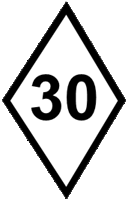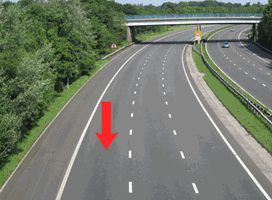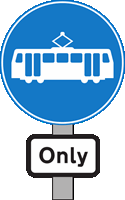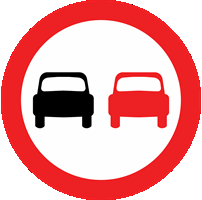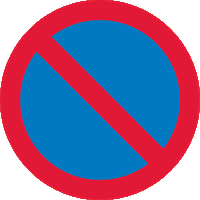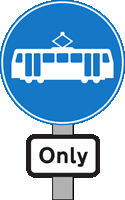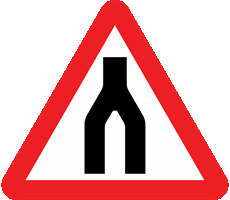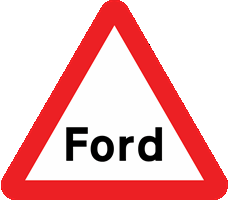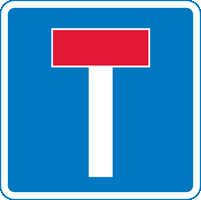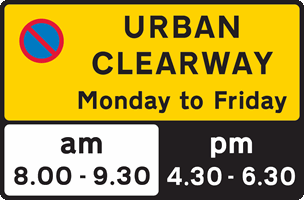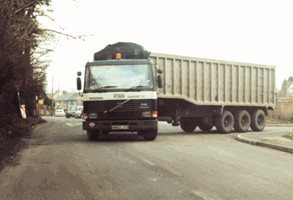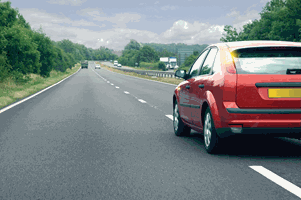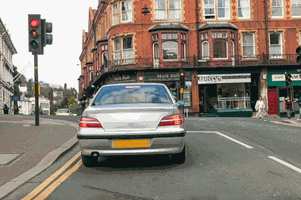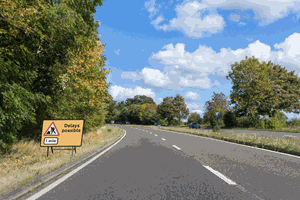You have 57 minutes to answer 50 multiple choice driving theory test questions. You need to answer at least 43 out of 50 questions correctly to pass. You can review your answer after each question or you can review all of your answers at the end of the test. Best of luck!
Test Quick View
Click on an answer to view the correct choice along with the explanation.
Correct Answer: D
Explanation: Diamond-shaped traffic signs are specific to tram drivers. However, drivers of other vehicles should know what they mean so they're aware of what the tram driver may do and what their priorities are.
Explanation: Diamond-shaped traffic signs are specific to tram drivers. However, drivers of other vehicles should know what they mean so they're aware of what the tram driver may do and what their priorities are.
Correct Answer: C
Explanation: Traffic-calming measures such as road humps, chicanes, and narrowings are designed to keep speeds low in areas with high numbers of pedestrians. The survival chances for a pedestrian hit by a vehicle at 20 mph are considerably higher than one hit by a vehicle at 40 mph.
Explanation: Traffic-calming measures such as road humps, chicanes, and narrowings are designed to keep speeds low in areas with high numbers of pedestrians. The survival chances for a pedestrian hit by a vehicle at 20 mph are considerably higher than one hit by a vehicle at 40 mph.
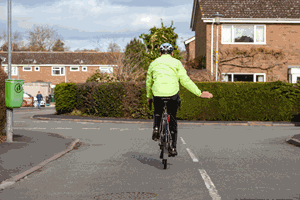
B
C
D
Correct Answer: B
Explanation: Don't get close to the cyclist or try to pass them, as this makes the situation dangerous. Stay back from them and give them space and time to turn.
Explanation: Don't get close to the cyclist or try to pass them, as this makes the situation dangerous. Stay back from them and give them space and time to turn.
Correct Answer: B
Explanation: The building means you don't have a good view of the road, and vehicles on the road don't have a good view of you. Creep forward slowly until you can see properly, and if you aren't certain that it's clear, don't pull out.
Explanation: The building means you don't have a good view of the road, and vehicles on the road don't have a good view of you. Creep forward slowly until you can see properly, and if you aren't certain that it's clear, don't pull out.
Correct Answer: A
Explanation: Unless overtaking, you should aim to use the left-hand lane at all times on a motorway. You should move back into this lane after overtaking, once you're safely past the slower vehicle. Remember to check your mirrors before switching lanes, and don't stay in the middle or right-hand lanes if you don't need to.
Explanation: Unless overtaking, you should aim to use the left-hand lane at all times on a motorway. You should move back into this lane after overtaking, once you're safely past the slower vehicle. Remember to check your mirrors before switching lanes, and don't stay in the middle or right-hand lanes if you don't need to.
6. How should you rejoin the motorway after fixing a problem with your car on the hard shoulder?
Mark one answer
B
C
D
Correct Answer: A
Explanation: Build up sufficient speed to re-join the motorway while signalling right to indicate your intentions. Only pull out from the hard shoulder when you're sure there is a safe gap to pull into, and aim not to affect the speed or direction of others.
Explanation: Build up sufficient speed to re-join the motorway while signalling right to indicate your intentions. Only pull out from the hard shoulder when you're sure there is a safe gap to pull into, and aim not to affect the speed or direction of others.
7. What is usually the speed limit in areas where there are street lights but no signs?
Mark one answer
B
C
D
Correct Answer: A
Explanation: Unless otherwise stated, any road with street lights has a 30 mph speed limit.
Explanation: Unless otherwise stated, any road with street lights has a 30 mph speed limit.
Correct Answer: D
Explanation: This sign indicates that the road is only for use by trams. As trams cannot leave their rails to manoeuvre around obstacles, you should never block tram routes. Take extra care in systems allowing motor vehicles and trams, as trams are quick and quiet, and could appear unexpectedly.
Explanation: This sign indicates that the road is only for use by trams. As trams cannot leave their rails to manoeuvre around obstacles, you should never block tram routes. Take extra care in systems allowing motor vehicles and trams, as trams are quick and quiet, and could appear unexpectedly.
Correct Answer: B
Explanation: This sign means 'no overtaking', and is found in areas where road conditions mean overtaking is too dangerous. Do not attempt to overtake in areas where this sign is present, even if the road ahead looks clear.
Explanation: This sign means 'no overtaking', and is found in areas where road conditions mean overtaking is too dangerous. Do not attempt to overtake in areas where this sign is present, even if the road ahead looks clear.
Correct Answer: D
Explanation: This sign means there are waiting restrictions. Numbers on this or an adjoining sign will tell you what the restrictions are.
Explanation: This sign means there are waiting restrictions. Numbers on this or an adjoining sign will tell you what the restrictions are.
Correct Answer: C
Explanation: This indicates there is a tram only route ahead. Trams are both quick and quiet, so take extra care in road systems that also accommodate them. Keep an eye out for road signs, markings, and tram rails, all of which will let you know if trams are in operation.
Explanation: This indicates there is a tram only route ahead. Trams are both quick and quiet, so take extra care in road systems that also accommodate them. Keep an eye out for road signs, markings, and tram rails, all of which will let you know if trams are in operation.
B
C
D
Correct Answer: C
Explanation: You might find this combination of lanes on a one-way street, with buses in one direction and bicycles in the other. A contraflow lane travels in the opposite direction from the main road's flow of traffic.
Explanation: You might find this combination of lanes on a one-way street, with buses in one direction and bicycles in the other. A contraflow lane travels in the opposite direction from the main road's flow of traffic.
Correct Answer: A
Explanation: The dual carriageway will shortly become a single carriageway. If overtaking, be sure that you're back into the left lane well before the dual carriageway ends. Relying on traffic letting you in at the last minute is not a good strategy.
Explanation: The dual carriageway will shortly become a single carriageway. If overtaking, be sure that you're back into the left lane well before the dual carriageway ends. Relying on traffic letting you in at the last minute is not a good strategy.
Correct Answer: D
Explanation: This sign warns of a stream crossing the road ahead. While these are usually safe to drive through, don't assume you can do so safely. The water level may be high following rainfall. If you have any doubts, find another route.
Explanation: This sign warns of a stream crossing the road ahead. While these are usually safe to drive through, don't assume you can do so safely. The water level may be high following rainfall. If you have any doubts, find another route.
Correct Answer: B
Explanation: This sign indicates that there is no through route ahead. It is a dead end, cul-de-sac, or isolated road system.
Explanation: This sign indicates that there is no through route ahead. It is a dead end, cul-de-sac, or isolated road system.
16. In which of these circumstances is it permitted to cross the solid double white lines in the middle of the road?
Mark one answer
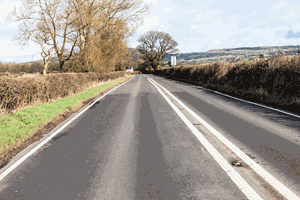
B
C
D
Correct Answer: C
Explanation: It is permitted to pass over the solid white line in the middle of the road to pass a stationary vehicle, or to overtake a cyclist, horse, or vehicle travelling at under 10 mph. Access to some properties might also require you to cross a solid white line; this is also permitted.
Explanation: It is permitted to pass over the solid white line in the middle of the road to pass a stationary vehicle, or to overtake a cyclist, horse, or vehicle travelling at under 10 mph. Access to some properties might also require you to cross a solid white line; this is also permitted.
Correct Answer: C
Explanation: Toucan crossings allow both cyclists and pedestrians to cross simultaneously. Cyclists may approach the crossing at high speeds, so be extra wary of this.
Explanation: Toucan crossings allow both cyclists and pedestrians to cross simultaneously. Cyclists may approach the crossing at high speeds, so be extra wary of this.
18. What colour are the reflective studs that identify the left-hand edge of the motorway?
Mark one answer

B
C
D
Correct Answer: C
Explanation: Red reflective studs line the left-hand edge of a motorway carriageway. You'll see white studs between lanes, amber studs on the right edge of the carriageway, and green studs between the carriageway and its slip roads. These studs can be used to help you determine your position in poor visibility.
Explanation: Red reflective studs line the left-hand edge of a motorway carriageway. You'll see white studs between lanes, amber studs on the right edge of the carriageway, and green studs between the carriageway and its slip roads. These studs can be used to help you determine your position in poor visibility.
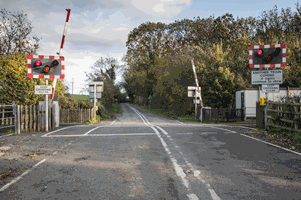
B
C
D
Correct Answer: D
Explanation: The flashing red lights indicate that a train will be passing shortly, and are shown before the barrier lowers and while it's down. You should stop before the white line. Some crossings display an amber light before the red lights. You should stop for this too, unless you've already passed the white line.
Explanation: The flashing red lights indicate that a train will be passing shortly, and are shown before the barrier lowers and while it's down. You should stop before the white line. Some crossings display an amber light before the red lights. You should stop for this too, unless you've already passed the white line.
Correct Answer: A
Explanation: You should not park at or near a bus stop, even if you only plan to be there for a moment. Disobeying this rule inconveniences bus drivers and passengers, and can make it dangerous for passengers (particularly the young or old) to disembark or board. Parking at or near a bus stop is selfish and needlessly dangerous.
Explanation: You should not park at or near a bus stop, even if you only plan to be there for a moment. Disobeying this rule inconveniences bus drivers and passengers, and can make it dangerous for passengers (particularly the young or old) to disembark or board. Parking at or near a bus stop is selfish and needlessly dangerous.
21. How do small, powered vehicles used by disabled people warn you of their presence on a dual carriageway?
Mark one answer
B
C
D
Correct Answer: A
Explanation: People riding low-powered vehicles such as disabled scooters will use flashing amber lights when on dual carriageways to compensate for being hard to see.
Explanation: People riding low-powered vehicles such as disabled scooters will use flashing amber lights when on dual carriageways to compensate for being hard to see.
Correct Answer: C
Explanation: This sign tells you when parking isn't permitted in this area; this is usually done to help keep traffic flowing. During these times, you are still permitted to collect or drop off passengers, but only if your stop is brief. Always check local signs for changes in times and operating hours.
Explanation: This sign tells you when parking isn't permitted in this area; this is usually done to help keep traffic flowing. During these times, you are still permitted to collect or drop off passengers, but only if your stop is brief. Always check local signs for changes in times and operating hours.
Correct Answer: C
Explanation: Lorries and other long vehicles need more space to safely complete turns like this, and it's not uncommon for them to temporarily use multiple lanes or carriageways. Slow down or stop to allow them the time and space they need.
Explanation: Lorries and other long vehicles need more space to safely complete turns like this, and it's not uncommon for them to temporarily use multiple lanes or carriageways. Slow down or stop to allow them the time and space they need.
Correct Answer: D
Explanation: The green light indicates that regular traffic can continue if it is safe to do so, while the white line tells trams to stop. Even if there are no trams where you normally drive, you should be familiar with signals applying to trams, as they're being introduced in more and more places.
Explanation: The green light indicates that regular traffic can continue if it is safe to do so, while the white line tells trams to stop. Even if there are no trams where you normally drive, you should be familiar with signals applying to trams, as they're being introduced in more and more places.
Correct Answer: B
Explanation: Motorway use is prohibited for mobility scooters (weighing less than 254kg), pedestrians, motorcycles under 50 cc, and certain other slow vehicles without permission.
Explanation: Motorway use is prohibited for mobility scooters (weighing less than 254kg), pedestrians, motorcycles under 50 cc, and certain other slow vehicles without permission.
Correct Answer: A
Explanation: Emergency refuge areas are areas at the side of the motorway that provide shelter and an emergency telephone that connects directly to a control centre. If you pulled over for an emergency but that emergency has now passed, take care re-joining the motorway, especially if the hard shoulder is being used as a normal lane.
Explanation: Emergency refuge areas are areas at the side of the motorway that provide shelter and an emergency telephone that connects directly to a control centre. If you pulled over for an emergency but that emergency has now passed, take care re-joining the motorway, especially if the hard shoulder is being used as a normal lane.
Correct Answer: B
Explanation: Smart motorways aim to reduce congestion, improve traffic flow, and make journey times reliable. You'll often find that the hard shoulder is used as a running lane during rush hour or following an accident to ease traffic flow. Smart motorways also have variable speed limits, so watch out for signs above the carriageway telling you the current limit.
Explanation: Smart motorways aim to reduce congestion, improve traffic flow, and make journey times reliable. You'll often find that the hard shoulder is used as a running lane during rush hour or following an accident to ease traffic flow. Smart motorways also have variable speed limits, so watch out for signs above the carriageway telling you the current limit.
Correct Answer: C
Explanation: Visibility is poor in areas with fog, and you won't be able to see hazards ahead as clearly or predict the actions of other road users. Leave a larger gap than normal between you and the vehicle in front to ensure you have time to brake if a hazard presents itself. If possible, avoid travelling in fog.
Explanation: Visibility is poor in areas with fog, and you won't be able to see hazards ahead as clearly or predict the actions of other road users. Leave a larger gap than normal between you and the vehicle in front to ensure you have time to brake if a hazard presents itself. If possible, avoid travelling in fog.
Correct Answer: A
Explanation: You should be checking your mirrors regularly, ensuring you always know what's ahead, beside, and behind you. Doing this will help you anticipate what might happen next, helping avoid and prevent hazards. It's especially important to check your mirrors when you spot a hazard.
Explanation: You should be checking your mirrors regularly, ensuring you always know what's ahead, beside, and behind you. Doing this will help you anticipate what might happen next, helping avoid and prevent hazards. It's especially important to check your mirrors when you spot a hazard.
Correct Answer: A
Explanation: This sign indicates a cycle route. To help reduce the impact of commuting on the environment, people in towns and cities are being encouraged to cycle, and cycle routes are becoming more common. Be courteous to cyclists. Don't drive in active cycle lanes, and give them plenty of room as you pass.
Explanation: This sign indicates a cycle route. To help reduce the impact of commuting on the environment, people in towns and cities are being encouraged to cycle, and cycle routes are becoming more common. Be courteous to cyclists. Don't drive in active cycle lanes, and give them plenty of room as you pass.
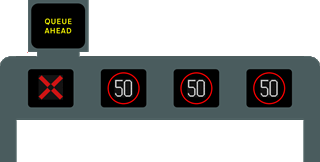
B
C
D
Correct Answer: C
Explanation: These signs indicate that the normal running lanes have a compulsory speed limit of 50 mph, and that the hard shoulder is currently only available for use in breakdowns and emergencies. The hard shoulder will sometimes be used as a running lane on smart motorways; if so, it will have a compulsory speed limit shown above it.
Explanation: These signs indicate that the normal running lanes have a compulsory speed limit of 50 mph, and that the hard shoulder is currently only available for use in breakdowns and emergencies. The hard shoulder will sometimes be used as a running lane on smart motorways; if so, it will have a compulsory speed limit shown above it.
B
C
D
Correct Answer: C
Explanation: Shock can be tricky to diagnose following a collision. Look out for pale, grey skin, sweating, a rapid pulse, and rapid, shallow breathing.
Explanation: Shock can be tricky to diagnose following a collision. Look out for pale, grey skin, sweating, a rapid pulse, and rapid, shallow breathing.
Correct Answer: A
Explanation: It is inevitable that other drivers will make bad decisions and mistakes. Keep calm and don't retaliate or driver aggressively. The safety of you, your passengers, and other road users should always come fire.
Explanation: It is inevitable that other drivers will make bad decisions and mistakes. Keep calm and don't retaliate or driver aggressively. The safety of you, your passengers, and other road users should always come fire.
Correct Answer: B
Explanation: You should check your mirrors for cyclists that might be moving past you. Cyclists often filter between lines of stationary traffic, so checking your mirrors is especially important in that scenario.
Explanation: You should check your mirrors for cyclists that might be moving past you. Cyclists often filter between lines of stationary traffic, so checking your mirrors is especially important in that scenario.
35. What should you do if you've just been prescribed drugs that are likely to affect your driving, but you desperately need to get home?
Mark one answer
B
C
D
Correct Answer: A
Explanation: Medicine that makes you drowsy also means you're unfit to drive. You should find another way home, or ask someone else to drive you.
Explanation: Medicine that makes you drowsy also means you're unfit to drive. You should find another way home, or ask someone else to drive you.
36. In a queue of traffic, why is it important to check your right mirror before turning right into a side road?
Mark one answer
B
C
D
Correct Answer: B
Explanation: You should check your side mirrors in case someone is overtaking. Cyclists and motorcyclists often filter through traffic and therefore appear quickly, so be sure to check there's no one passing you before you turn.
Explanation: You should check your side mirrors in case someone is overtaking. Cyclists and motorcyclists often filter through traffic and therefore appear quickly, so be sure to check there's no one passing you before you turn.
37. What should you do if you're driving on a busy main road but notice you're going in the wrong direction?
Mark one answer
B
C
D
Correct Answer: D
Explanation: If you discover you're going the wrong way, you should find a side road to turn around in. Don't attempt a U-turn or reverse from a side road onto the main road. Watch for pedestrians, cyclists, and other vehicles as you turn around, and ensure you're not obstructing any entrances or exits.
Explanation: If you discover you're going the wrong way, you should find a side road to turn around in. Don't attempt a U-turn or reverse from a side road onto the main road. Watch for pedestrians, cyclists, and other vehicles as you turn around, and ensure you're not obstructing any entrances or exits.
B
C
D
Correct Answer: B
Explanation: The most dangerous part of the manoeuvre is as your vehicle's front swings around. Ensure you check all directions before beginning to reverse into a side road, and be sure to stop and wait if a hazard presents itself.
Explanation: The most dangerous part of the manoeuvre is as your vehicle's front swings around. Ensure you check all directions before beginning to reverse into a side road, and be sure to stop and wait if a hazard presents itself.
Correct Answer: D
Explanation: Always ensure your vehicle is locked and the key is removed before leaving your vehicle. Leaving the keys with your vehicle makes it easy for a thief to steal it, and might invalidate your insurance.
Explanation: Always ensure your vehicle is locked and the key is removed before leaving your vehicle. Leaving the keys with your vehicle makes it easy for a thief to steal it, and might invalidate your insurance.
Correct Answer: B
Explanation: Your stopping distance could be double the normal stopping distance in wet weather. Take extra care.
Explanation: Your stopping distance could be double the normal stopping distance in wet weather. Take extra care.
Correct Answer: D
Explanation: This sign indicates that there may be people working in the road ahead. You may need to slow down or stop if there are hazards in the road. Ensure you check your mirrors before changing speed or direction, and look further along the road for more signs or roadworks.
Explanation: This sign indicates that there may be people working in the road ahead. You may need to slow down or stop if there are hazards in the road. Ensure you check your mirrors before changing speed or direction, and look further along the road for more signs or roadworks.
Correct Answer: A
Explanation: You should use dipped headlights when driving on busy motorways. Your full-beam headlights will dazzle both drivers ahead of you and those on the other side of the motorway. Dipped headlights should ensure others aren't dazzled.
Explanation: You should use dipped headlights when driving on busy motorways. Your full-beam headlights will dazzle both drivers ahead of you and those on the other side of the motorway. Dipped headlights should ensure others aren't dazzled.
43. When leaving your vehicle unattended for just a few minutes, what should you do?
Mark one answer
B
C
D
Correct Answer: D
Explanation: Whenever you leave your vehicle - even if it's only for a minute or two - you should remove your keys and lock it.
Explanation: Whenever you leave your vehicle - even if it's only for a minute or two - you should remove your keys and lock it.
44. You should leave a two-second gap between you and the vehicle in front under which conditions?
Mark one answer

B
C
D
Correct Answer: A
Explanation: Use the 'two-second rule' in good, dry conditions, staying at least two seconds from any vehicle in front. This allows time and space for you to stop if the driver ahead stops suddenly
Explanation: Use the 'two-second rule' in good, dry conditions, staying at least two seconds from any vehicle in front. This allows time and space for you to stop if the driver ahead stops suddenly
45. Which of these schemes will reduce the risk of a car being broken into at night?
Mark one answer
B
C
D
Correct Answer: D
Explanation: Vehicle Watch Scheme stickers invite police to stop your vehicle if it's seen being used between midnight and 5am. Presence of the sticker in your car will deter thieves from stealing it, and increase the odds of the thief being caught if they do steal it.
Explanation: Vehicle Watch Scheme stickers invite police to stop your vehicle if it's seen being used between midnight and 5am. Presence of the sticker in your car will deter thieves from stealing it, and increase the odds of the thief being caught if they do steal it.
Correct Answer: B
Explanation: Engine braking happens when you select a lower gear. It's especially useful for controlling your speed while going downhill, and spares you using your brakes the whole way down. Excessive use of your brakes can cause them to overheat, which makes them less effective.
Explanation: Engine braking happens when you select a lower gear. It's especially useful for controlling your speed while going downhill, and spares you using your brakes the whole way down. Excessive use of your brakes can cause them to overheat, which makes them less effective.
Correct Answer: A
Explanation: Breakaway cables activate a trailer's brakes automatically if the trailer becomes detached from the towing vehicle. The towing vehicle then has a chance to get clear of the trailer, and the trailer has a greater chance of stopping before causing an incident.
Explanation: Breakaway cables activate a trailer's brakes automatically if the trailer becomes detached from the towing vehicle. The towing vehicle then has a chance to get clear of the trailer, and the trailer has a greater chance of stopping before causing an incident.
Correct Answer: C
Explanation: Third-party insurance is the minimum insurance cover required by law. In the event of an incident, this only covers damage to other vehicles and injury to other people, not damage or injury to you and your vehicle. Fire damage and theft are also not covered. Speak to your insurance company about your requirements to determine which type of insurance is best for your needs.
Explanation: Third-party insurance is the minimum insurance cover required by law. In the event of an incident, this only covers damage to other vehicles and injury to other people, not damage or injury to you and your vehicle. Fire damage and theft are also not covered. Speak to your insurance company about your requirements to determine which type of insurance is best for your needs.
Correct Answer: A
Explanation: It pays to be prepared, and having a first aid kit and fire extinguisher on-board could even save lives.
Explanation: It pays to be prepared, and having a first aid kit and fire extinguisher on-board could even save lives.
B
C
D
Correct Answer: A
Explanation: You should report the collision to the police as soon as possible, and never later than 24 hours afterwards.
Explanation: You should report the collision to the police as soon as possible, and never later than 24 hours afterwards.



